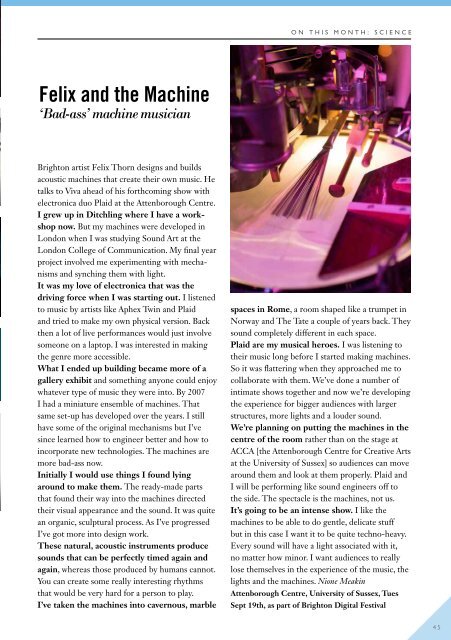Create successful ePaper yourself
Turn your PDF publications into a flip-book with our unique Google optimized e-Paper software.
ON THIS MONTH: SCIENCE<br />
Felix and the Machine<br />
‘Bad-ass’ machine musician<br />
Brighton artist Felix Thorn designs and builds<br />
acoustic machines that create their own music. He<br />
talks to <strong>Viva</strong> ahead of his forthcoming show with<br />
electronica duo Plaid at the Attenborough Centre.<br />
I grew up in Ditchling where I have a workshop<br />
now. But my machines were developed in<br />
London when I was studying Sound Art at the<br />
London College of Communication. My final year<br />
project involved me experimenting with mechanisms<br />
and synching them with light.<br />
It was my love of electronica that was the<br />
driving force when I was starting out. I listened<br />
to music by artists like Aphex Twin and Plaid<br />
and tried to make my own physical version. Back<br />
then a lot of live performances would just involve<br />
someone on a laptop. I was interested in making<br />
the genre more accessible.<br />
What I ended up building became more of a<br />
gallery exhibit and something anyone could enjoy<br />
whatever type of music they were into. By 2007<br />
I had a miniature ensemble of machines. That<br />
same set-up has developed over the years. I still<br />
have some of the original mechanisms but I’ve<br />
since learned how to engineer better and how to<br />
incorporate new technologies. The machines are<br />
more bad-ass now.<br />
Initially I would use things I found lying<br />
around to make them. The ready-made parts<br />
that found their way into the machines directed<br />
their visual appearance and the sound. It was quite<br />
an organic, sculptural process. As I’ve progressed<br />
I’ve got more into design work.<br />
These natural, acoustic instruments produce<br />
sounds that can be perfectly timed again and<br />
again, whereas those produced by humans cannot.<br />
You can create some really interesting rhythms<br />
that would be very hard for a person to play.<br />
I’ve taken the machines into cavernous, marble<br />
spaces in Rome, a room shaped like a trumpet in<br />
Norway and The Tate a couple of years back. They<br />
sound completely different in each space.<br />
Plaid are my musical heroes. I was listening to<br />
their music long before I started making machines.<br />
So it was flattering when they approached me to<br />
collaborate with them. We’ve done a number of<br />
intimate shows together and now we’re developing<br />
the experience for bigger audiences with larger<br />
structures, more lights and a louder sound.<br />
We’re planning on putting the machines in the<br />
centre of the room rather than on the stage at<br />
ACCA [the Attenborough Centre for Creative Arts<br />
at the University of Sussex] so audiences can move<br />
around them and look at them properly. Plaid and<br />
I will be performing like sound engineers off to<br />
the side. The spectacle is the machines, not us.<br />
It’s going to be an intense show. I like the<br />
machines to be able to do gentle, delicate stuff<br />
but in this case I want it to be quite techno-heavy.<br />
Every sound will have a light associated with it,<br />
no matter how minor. I want audiences to really<br />
lose themselves in the experience of the music, the<br />
lights and the machines. Nione Meakin<br />
Attenborough Centre, University of Sussex, Tues<br />
Sept 19th, as part of Brighton Digital Festival<br />
45


















